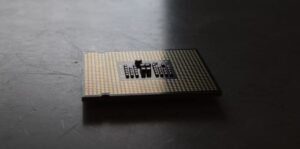When to Charge Tesla Model 3
As an owner of a Tesla Model 3, it’s important to understand the best practices for charging your electric vehicle (EV) to maximize its performance and battery life. By following a few guidelines, you can ensure optimal charging times and efficiency.
Key Takeaways:
- Understand different charging levels to select the appropriate option for your needs.
- High-voltage charging at Supercharging stations is the quickest way to charge your Model 3.
- Avoid charging above 90% regularly for extended battery health.
- Set up a charging routine based on your daily usage and charging availability.
Charging Levels and Options
When it comes to charging your Tesla Model 3, there are three main levels to consider:
- Level 1 (120V AC): This is the basic charging method that utilizes a standard household outlet. It provides a slow charging rate of approximately 4-5 miles of range per hour.
- Level 2 (240V AC): This option requires the installation of a dedicated charger, commonly referred to as a home charging station. It provides a faster charging rate of around 30-40 miles of range per hour.
- Level 3 (DC Fast Charging): Tesla Supercharging stations offer high-voltage DC fast charging and provide the fastest charging speeds. They can add up to 170 miles of range in just 30 minutes.
Interesting fact: Level 3 Supercharging stations are strategically located along major highways and key travel routes to facilitate long-distance travel for Tesla owners.
Optimal Charging Levels
While you have the ability to charge your Tesla Model 3 up to 100%, it’s recommended to avoid regularly charging above 90% for an extended period. This helps preserve the longevity of your battery’s health.
Interesting fact: Tesla intentionally leaves a small buffer between the displayed battery percentage and the actual battery capacity to protect against overcharging and to keep the battery within its optimal temperature range.
It’s advisable to maintain a daily charging routine that keeps your battery level between 20-80%, as this range offers a good balance between convenience and long-term battery health.
Charging Routine and Flexibility
Creating a consistent charging routine based on your daily usage can help optimize charging times and reduce the need for sudden or frequent charging sessions. Consider the following tips:
- Charge overnight at home when electricity rates are often lower.
- Make use of scheduled charging in your Tesla mobile app to take advantage of off-peak electricity rates.
- Plan your trips and utilize Supercharger stations strategically for long-distance travel.
Charging Time Estimates
| Charging Level | Approximate Range Added Per Hour |
|---|---|
| Level 1 (120V AC) | 4-5 miles |
| Level 2 (240V AC) | 30-40 miles |
| Level 3 (Supercharger) | Up to 170 miles (30 minutes) |
Preventing Battery Degradation
To maintain your Tesla Model 3’s battery health, it’s essential to keep the battery within optimal operating conditions. Here are some practices to help prevent battery degradation:
- Avoid exposing the vehicle to extreme temperatures for extended periods.
- Minimize the usage of high-powered features, such as Ludicrous Mode, to reduce stress on the battery.
- Regularly update your Tesla software to benefit from performance optimizations and battery management improvements.
Charge Smart, Drive Far
With the right charging knowledge and routine, you can enjoy the benefits of driving a Tesla Model 3 while optimizing its performance, battery health, and range. By understanding the charging levels, adopting a suitable routine, and considering the charging options available, you’ll be able to make the most of your electric vehicle.

Common Misconceptions
Misconception 1: Charging Overnight is Always the Best Option
One common misconception about charging a Tesla Model 3 is that it is always best to charge it overnight. While it is true that overnight charging can be convenient for many, there are other factors to consider:
- Charging during off-peak hours can reduce electricity costs.
- If you have access to solar panels or renewable energy sources during the day, charging during daylight hours can help minimize your carbon footprint.
- Charging during the day when the temperature is cooler may result in faster charging times.
Misconception 2: You Need to Fully Charge the Battery Every Time
Another misconception is that you need to fully charge the Tesla Model 3 battery every time you charge it. However, it is not always necessary to reach a full charge:
- For daily commutes and short trips, charging to around 80% can be sufficient and help prolong the battery’s lifespan.
- Long-term storage of the vehicle is best done with a charge level between 50-60%.
- It is alright to occasionally fully charge the battery for longer trips, but regular usage can be done with partial charges.
Misconception 3: Rapid Charging is Harmful to the Battery
Some people believe that rapid charging, such as using Superchargers, can be harmful to the Tesla Model 3 battery. While rapid charging can have some minor effects, it is generally safe to use:
- Superchargers are designed to charge the battery quickly without causing significant harm.
- Using Superchargers occasionally for long trips won’t have a noticeable impact on battery lifespan.
- Regular use of Superchargers may result in slightly higher degradation over time compared to home charging, but it’s within an acceptable range.
Misconception 4: Charging to 100% is Always Advisable for Long Trips
While it is important to have enough charge for longer trips, it is not always advisable to charge the battery to 100%:
- Charging to 100% often can put more strain on the battery and contribute to faster degradation over time.
- Charging to around 90-95% is generally enough to cover unexpected detours or delays.
- Some Tesla owners suggest using the “Trip” charging mode, which will automatically charge the battery to the required level based on the navigation route for long trips.
Misconception 5: You Should Charge Whenever the Battery is Low
Contrary to popular belief, there is no need to panic and charge the Tesla Model 3 every time the battery level is low:
- Tesla batteries have a built-in buffer that keeps a small reserve even when the indicated battery level is low.
- It is possible to safely drive the vehicle to a nearby charging station without depleting the battery completely.
- Waiting to charge until you reach a dedicated charging station can save time and allow for a more efficient charging process.

How Long it Takes to Charge a Tesla Model 3 at Different Charging Stations
The following table illustrates the time it takes to fully charge a Tesla Model 3 at different charging stations. The charging times may vary depending on factors such as the battery level, temperature, and available charging power.
| Charging Station | Charging Time |
|---|---|
| Standard Household Outlet (120V) | Up to 4 days |
| Level 2 Charging Station (240V) | Around 8-12 hours |
| Tesla Home Charger (Wall Connector) | Approximately 3-6 hours |
| Tesla Supercharger (120 kW) | Up to 75 minutes |
The Cost of Charging a Tesla Model 3 at Different Locations
This table displays the approximate cost of charging a Tesla Model 3 at various charging locations. The prices may vary due to different electricity rates and pricing structures.
| Charging Location | Charging Cost |
|---|---|
| Home (Average Electricity Rate) | $7.00 for a full charge |
| Public Charging Station (Average Price) | $11.50 for a full charge |
| Tesla Supercharger (Per kWh) | $0.28 per kWh |
| Tesla Destination Charger (Per kWh) | $0.15 per kWh |
The Range Added per Hour of Charging at Different Levels
This table showcases the approximate range added to a Tesla Model 3 per hour of charging at various levels. The actual range may differ based on driving conditions and battery health.
| Charging Level | Range Added per Hour |
|---|---|
| Standard Household Outlet (120V) | 2-4 miles |
| Level 2 Charging Station (240V) | 15-30 miles |
| Tesla Home Charger (Wall Connector) | 30-60 miles |
| Tesla Supercharger (120 kW) | 180-300 miles |
The Impact of Temperature on Charging Efficiency
This table explores the impact of temperature on the charging efficiency of a Tesla Model 3. As temperature decreases, charging efficiency may be reduced.
| Temperature | Charging Efficiency |
|---|---|
| 32°F (0°C) | Around 90% |
| 68°F (20°C) | Around 95% |
| 104°F (40°C) | Up to 100% |
Comparison of Tesla Model 3 Charging Speeds
This table provides a comparison of the charging speeds between different versions of the Tesla Model 3. The charging time may vary based on battery capacity and charging capabilities of each model.
| Tesla Model 3 Version | Charging Speed (Miles per Hour) |
|---|---|
| Standard Range Plus | Up to 44 miles |
| Long Range | Up to 54 miles |
| Performance | Up to 54 miles |
Comparison of Tesla Model 3 Battery Sizes
This table compares the battery sizes of different versions of the Tesla Model 3, affecting the range and overall charging time.
| Tesla Model 3 Version | Battery Size (kWh) |
|---|---|
| Standard Range Plus | 54 kWh |
| Long Range | 75 kWh |
| Performance | 75 kWh |
Comparison of Charging Networks for Tesla Model 3
This table compares different charging networks available for Tesla Model 3 owners. Each network offers varying coverage, charging speed, and additional amenities.
| Charging Network | Coverage | Charging Speed | Amenities |
|---|---|---|---|
| Tesla Supercharger Network | Extensive | Up to 120 kW | Restrooms, Food, Wi-Fi |
| Electrify America | Nationwide | Up to 350 kW | Restrooms, Dining, Shops |
| ChargePoint | Extensive | Varies (Up to 80 kW) | Restrooms, Shopping |
Comparison of Tesla Model 3 Charging Connectors
This table compares the different charging connectors compatible with Tesla Model 3 and their availability at various charging stations.
| Charging Connector | Availability | Compatible Stations |
|---|---|---|
| Tesla Supercharger (CCS Combo 2) | Widely available | Tesla Supercharger Network |
| J1772 (Level 2) | Common | Public Charging Stations |
| NEMA 5-15 (Standard Outlet) | Everywhere | Home, Public |
The Impact of Charging Speed on Battery Health
This table demonstrates the impact of charging speed on the long-term health of a Tesla Model 3 battery.
| Charging Speed | Effect on Battery Health |
|---|---|
| Slow Charging (Level 1/2) | Optimal for battery longevity |
| Fast Charging (Supercharger) | Accelerated battery degradation over time |
| Extreme Fast Charging (350 kW) | Potential for significant battery stress |
To maximize your Tesla Model 3 charging experience, consider the charging station options available, the cost implications, the impact of temperature, and the most suitable charging speed for long-term battery health. Always refer to the latest charging information provided by Tesla for accurate and up-to-date details.
Frequently Asked Questions – When to Charge Tesla Model 3
Q: How often should I charge my Tesla Model 3?
It is recommended to charge your Tesla Model 3 whenever possible, especially if you have access to a charging station or can charge at home. Regularly charging your car helps maintain the battery’s state of charge and ensures you have sufficient range for your daily needs.
Q: Should I wait until my Tesla Model 3 battery is almost empty before charging?
No, it is not necessary to wait until the battery is almost empty before charging. Tesla recommends keeping your car plugged in whenever it is not in use to ensure the battery is optimally charged and ready for your next drive. Frequent charging sessions can also help extend the battery’s lifespan.
Q: Can I leave my Tesla Model 3 plugged in overnight?
Yes, leaving your Tesla Model 3 plugged in overnight is perfectly safe and actually beneficial for the battery. The car’s charging system is designed to stop charging when the battery reaches its capacity, so you can rest assured that there will be no overcharging.
Q: How long does it take to fully charge a Tesla Model 3?
The time it takes to fully charge a Tesla Model 3 depends on various factors, such as the charging method and the battery’s current state of charge. With a standard home charger (Level 1), it may take about 48-72 hours to fully charge from a very low level. However, using a Level 2 charger or a Supercharger can significantly reduce charging time.
Q: Can I charge my Tesla Model 3 at any public charging station?
Yes, you can charge your Tesla Model 3 at most public charging stations. However, it is essential to have the appropriate charging adapter or cable for the station you are using. Most public charging stations are equipped with Type 2 connectors, but it’s always a good idea to check in advance and carry the necessary adapters.
Q: Is it necessary to charge my Tesla Model 3 to 100% every time?
No, it is not necessary to charge your Tesla Model 3 to 100% every time. Tesla recommends setting your daily charging limit to less than the full battery capacity unless you are planning a long trip. This helps optimize the battery’s lifespan and performance in the long run.
Q: Can I charge my Tesla Model 3 with a portable charger?
Yes, Tesla provides a portable charger, called a Mobile Connector, with every new Model 3. This charger can be plugged into a standard electrical outlet and allows you to charge your car wherever you have access to a power source. However, note that charging with a portable charger is typically slower than using a dedicated home or public charging station.
Q: Will frequent fast-charging affect the battery life of my Tesla Model 3?
Frequent fast-charging can have a slight impact on the overall battery lifespan of your Tesla Model 3. However, Tesla’s battery management system is designed to mitigate the effects and minimize any degradation. When possible, it is still recommended to use slower charging methods, such as home or workplace charging, to maintain the battery’s health.
Q: Can I pre-set the charging time for my Tesla Model 3?
Yes, you can pre-set the charging time for your Tesla Model 3 using the car’s onboard charging settings. This feature allows you to schedule charging during off-peak hours or when electricity rates are lower, maximizing your charging efficiency and cost savings.
Q: Should I charge my Tesla Model 3 to a specific percentage before long trips?
It is generally recommended to charge your Tesla Model 3 to a sufficient percentage before embarking on long trips. Tesla suggests charging to at least 90% or more to ensure you have a comfortable range and avoid unnecessary stops for charging along the way. Use the car’s navigation system or Tesla mobile app to plan your charging stops and optimize the journey.




